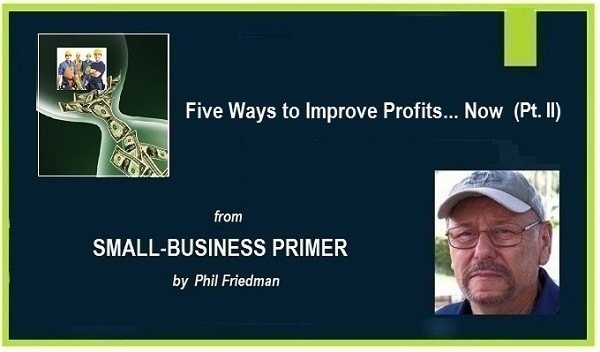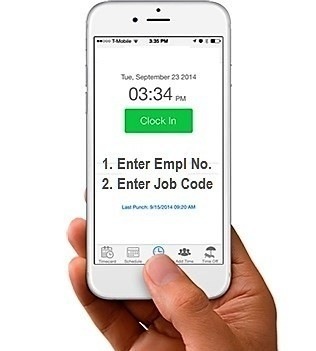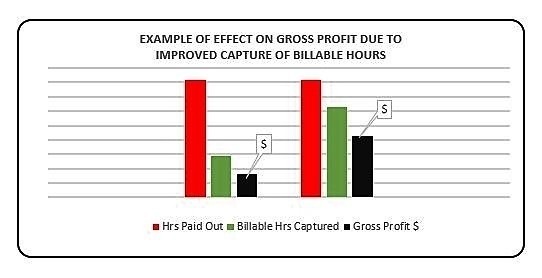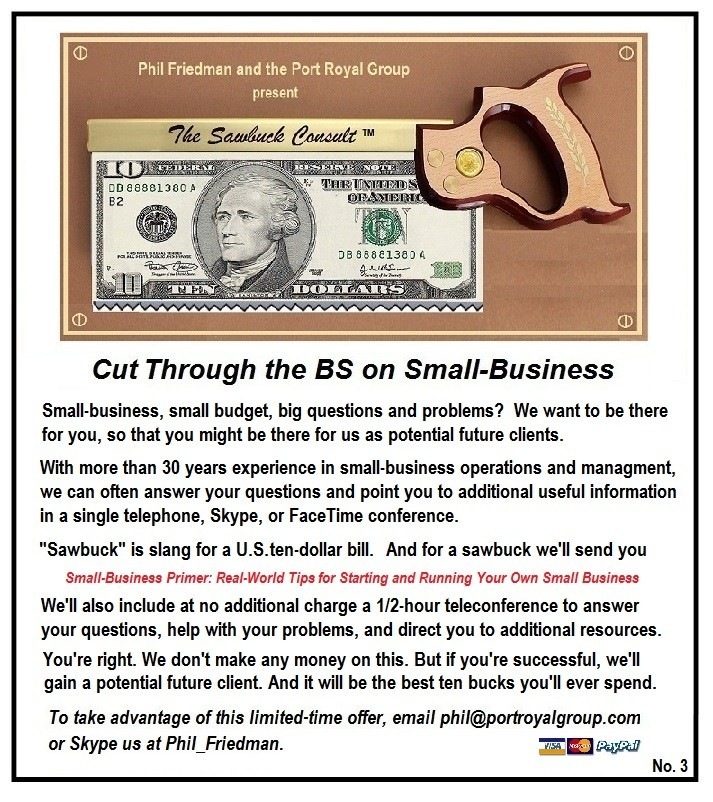Five Ways to Improve Your Small-Business Profits... Now (Pt. II)

IMPROVE CAPTURE OF BILLABLE HOURS TO BOOST GROSS PROFIT WITHOUT ADDED OVERHEADS...
Preface: This is the second installment of a serialization of my upcoming eBook, Small-Business Primer: Real -World Tips for Starting and Running Your Small Business.
Subsequent installments will be published at irregular intervals over the next year. Should you not want to wait for the serialization to run its course, details of how to secure a copy of the book in its entirety will be found at the end of this article.
The "case studies" cited in this series generally involve the reorganization and expansion of boatyard operations which I undertook over the last decade or so, as part of my core consulting business. Keep in mind, however, that the suggestions outlined here are equally applicable to just about any small business operation that sells products and/or services.
A common oversight in small-business contexts is failure to fully capture billable service hours...

During the course of a recent consult in the reorganization and expansion of service operations for a small full-service boatyard, I reviewed the previous fiscal year’s shop labor hours paid out against the number of shop labor hours billed to customers. Guess what I discovered.
Fewer than 35% of the expensed (paid out) hours had been captured in billings.
Now, you might think that would be fatally disastrous. You might also think it was something that should have been easily evident to all involved at the firm in management. But neither of those expectations proved to be true.
The retail shop labor rate was, in fact, nearly three times that of the partially burdened average hourly payroll cost. Consequently, the operation’s service labor component was being billed at approximate break-even. Unfortunately, break-even isn't enough — if your small business is more than just a hobby.
In the case in point, further analysis disclosed that an antiquated system for tracking labor hours depended entirely on the shop floor techs.
Well, you say, isn’t that natural? Aren’t they in the best position to track and report the labor hours they expend?
The short answers are no... and no. The practice of leaving it to the shop floor techs (or other tradesmen or craftsmen) to track and capture labor hours expended may be common, but it is definitely not natural.
Although it may seem counter-intuitive, relying on your shop floor techs for tracking billable labor hours is almost always significantly less than optimal. Instead, when it comes to assuring accurate capture of billable hours, the better course is to rely on a more objective approach. Why?
Because there is a natural tendency on the part of technicians, who get paid on an hourly basis for a fixed number of hours per week, to underestimate the number of hours they expend on a job...

In the case under discussion, the techs were entering their hours on job timecards, but failing to account for time taken up by:
1. Diagnosing the scope of the problem and identifying what had to be done
2. Picking and pricing necessary parts and materials
3. Getting the necessary tools and parts together
4. Setting up the work site
5. Taking down and clearing equipment and tools, and cleaning up the worksite.
All of these sub-operations were recognized by as part of the job in the relevant major flat-rate manuals. Yet, not one tech I questioned thought these activities are actually part of the billable work. To the contrary, their almost universal concept was that the job proper only begins when, speaking figuratively, wrench first touches bolt.
In order to gain control of the situation, we implemented the use of a relatively low-cost digital time clock, with both WiFi connection to the operation’s computer network and internet-based connection to the techs’ smartphones.
This enabled every tech to sign into and out of jobs real time from anywhere on the operation's premises or in the field, when on mobile assignments.
Each tech was assigned a unique three-digit employee code, and each job was assigned a four-digit code (the last four digits of the work order number). The sign-in and sign-out were about as simple as it gets. Key in the employee code, hit either the “in” or “out” button, then key in the job code. An entry took all of a maximum five seconds.
The time clock had its own onboard computer, which maintained the data when not in communication with the company’s main server. The time clock data could be imported to the company’s system as a comma-delimited file or as an Excel spreadsheet, so could be seamlessly flowed into the company’s payroll accounting system.

Recognizing that not everything a technician does on the shop floor is billable to a customer, we established several general house job codes, for instance, a code for shop equipment maintenance and repair. We also established standing codes for the other profit centers in the company, so that a specific work order generated for one of the company's other internal profit centers, generated billable hours for the service department.
Training and orientation for the technicians were relatively simple and short. After an initial orientation period that gave everyone a chance to adapt, we moved to paying the techs strictly from the time clock data. That meant it was in their own best interests to accurately capture billable hours using the timekeeping system. And once that reality sunk in, cooperation and diligence in recording billable hours rose effectively to 100%.
The primary objective of improving the capture of billable hours was to improve Gross Profit on service work. And the dramatic effects of the tactic are illustrated in the accompanying chart below...

Moreover, even if it didn’t enable the yard to bill every tech hour for which the boatyard had to pay, it nevertheless provided an infinitely more reliable tally of hours allocated to various jobs, a tally that could be used for statistical review and adjustment of the boatyard’s estimating templates and resource allocation planning. This was all exceedingly useful, even when working on firm, fixed pricing, as opposed to time and materials (T&M).
Hardware and software initial cost, in this case, was less than $700 for a system that would handle up to 50 techs, and several hundred jobs running simultaneously. This was excluding any costs for smartphones to communicate with the system from the field.
In the case in point, the effect of improving the capture of Service Division billable hours on gross profit was dramatic. Billable hours invoiced to customers rose from 35% to 77% of hours paid out. And gross margin on service labor rose from 5% to 57% — a stunning difference without even starting to scratch the surface of such issues as improvements to working efficiencies.
Of course, not every operation’s results will be this dramatic. Much depends on where you start. The point is, however, that improved capture of billable hours is a relatively easy and low-cost way to boost gross profit. — Phil Friedman
Author's notes: The next installment will deal with boosting profits by means of promotions to level-load existing resources across seasonal variations.
If you found this article of value, you might also want to look at some of my other writing about small business operations, management, and marketing:
"Five Ways to Improve Profits... Now (Pt. I)"
"Common Myths About Starting Your Own Small-Business"
"Small Businesses Need to Keep a Close Eye on Gross Profit"
For information on securing a copy of "Small-Business Primer: Real -World Tips for Starting and Running Your Own Small Business", email phil@portroyalgroup.com and put "small-business book" on the subject line.
To receive notifications of my writings on a regular basis, click the [FOLLOW] button on this page. As a writer-friend of mine says, you can always change your mind later.
Feel free to "like" and "share" this post and my other LinkedIn articles — whether on LinkedIn, Twitter, Facebook, or Google+. I ask only that you credit me properly as the author, and include a live link to the original work.
About me, Phil Friedman: With 30 some years background in the marine industry, I've worn numerous hats — as a yacht designer, boat builder, marine operations and business manager, marine industry consultant, marine marketing and communications specialist, yachting magazine writer and editor, yacht surveyor, and marine industry educator. I am also trained and experienced in interest-based negotiation and mediation. In a previous life, I taught logic and philosophy at university.



""""""""
Articles from Phil Friedman
View blog
A RECAP OF RECENT ARTICLES WRITTEN AND PUBLISHED BY PHIL FRIEDMAN... · Thanks to Don Philpott☘️ whos ...

GRUMPY AND GROUCHY TAKE A CRITICAL LOOK AT THE HONEY FACTORY... · Preface: · When Jim Murray and I f ...

THE DYNAMIC DUO OF DUMPING-ON-EVERYTHING IS BACK … EDGIER THAN EVER… · PHIL: Well, Jimbo, it’s been ...
Related professionals
You may be interested in these jobs
-

Carhop or Skating Carhop
Found in: beBee S2 US - 2 weeks ago
Sonic Carencro, United States Full timeThe Job: · As a SONIC Drive-In Carhop, your primary responsibility is to provide every guest with a SuperSONIC experience by: · • Delivering a warm, friendly, and fast experience to every guest · • Being a menu genius and helping SONIC customers navigate all customizable combina ...
-
Leesburg - Home Care Service with Great pay
Found in: Talent US 2A C2 - 6 days ago
Assisting Hands of Loudoun Ashburn, United States Full time, Part timeAssisting Hands of Loudoun is seeking caregivers that have experience in working with the elderly that live at their home. Our territory is mostly Leesburg, VA and Ashburn, VA. We need daytime on the weekends. Looking to fill 4 to 8 hour shifts that pays from $17 to $20 per hour. ...
-
Litigation Of Counsel
Found in: Lensa US P 2 C2 - 2 days ago
BCG Attorney Search Washington DC, United StatesA law firm in Washington, DC is seeking a highly experienced Litigation Of Counsel with a focus on product liability and/or complex commercial litigation. The ideal candidate should have a minimum of 8 years of litigation experience, preferably gained at an AmLaw 100 firm, and po ...



Comments
Phil Friedman
5 years ago #6
Thank you, Jerry Fletcher, for the kind words. I agree that the single most difficult decision for the independent small-business or consultant to make is to price at a profitable level. Too many fear losing the business to competitors who might price lower. Well, most of the time you just have to suck it up, do your research, and price squarely in the middle of the market.Cheers!
Phil Friedman
5 years ago #5
Thanks, Claire L Cardwell, for sharing this Part II in addition to Part I. Hope you are well. My Best. And cheers!
Phil Friedman
5 years ago #4
Jerry Fletcher, thank you for the kind words. Those of us who sell not so much what we DO as what we KNOW need to get away from hourly billing. Because the value of access to our in-depth experience is to shorten the time from trial to error to redirection to success. And the fewer hours we devote to getting the job done, the more valuable our services become. Cheers!
Phil Friedman
5 years ago #3
Thanks for reading and for pointing this out, Pascal Derrien. Cheers, my friend!
Jerry Fletcher
5 years ago #2
Pascal Derrien
5 years ago #1